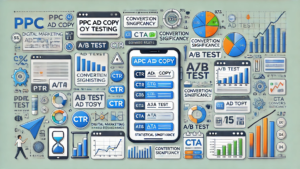Advertising copy tests to enhance PPC performance: –
Creating impactful ads is key to driving PPC performance. Here are some foundational guidelines, tips, and tricks to optimize your ad copy testing.

Establish a Hypothesis for Improvement
Begin with a clear hypothesis on how changes might enhance conversion rates. Gather sufficient data for each test to reach statistical significance.
To achieve reliable results:
Aim for statistical significance and increased performance.
According to Google, tests should run until one of the following is met:
A variant reaches a 95% chance of outperforming the baseline (use a free A/B calculator to assess this).
Two weeks pass to account for traffic variations.
Define a Testing Timeframe
Running tests without an end point leads to unreliable data. Set a timeframe for each test to gather actionable insights and avoid prolonged, inconclusive tests.
If a test yields no clear result, that’s fine—adjust and try again.
Key areas for ad copy testing:
Numerical Abbreviations vs. Integer Values
Using numbers in ads whether for inventory, discounts, or prices draws attention.
Numerical values stand out and reduce the noise generated by other PPC ads.
Adjusting Prices in Ads
Pricing in ads is a double-edged sword:
It can either inform buyers, prompting decisions, or deter them by highlighting cost. Data shows that only 40% of top-performing branded ads and 37% of non-branded ads include prices.
Experiment with how pricing is displayed to increase CTR, especially with normalized or reduced price displays.
Experiment with Promotions
Quantify your promotions in terms of discounts, special offers, or limited-time pricing.
This can add urgency and appeal, which enhances ad performance.
Punctuation Variations
Simple punctuation tweaks can make a big difference.
Analysis of high-performing ads found that:
Exclamation points are used in 48% of branded ads.
Commas in 25%, question marks in 11%, percentages in 9%, and dollar signs in 8%.
Try using punctuation strategically to attract attention and connect with emotions.
Leverage Emotional Appeal
Ads that tap into emotions see higher CTRs.
Consider the target audience’s feelings, problems, and desires.
Emotional headlines often drive stronger engagement, so use a headline analyzer to test impact.
Test Different Calls to Action (CTAs)
CTAs are crucial to driving responses.
Experiment with the first word in the CTA; verbs often create the most urgency.
For example:
– “**Contact us today**” vs. “**Call us now**” may affect CTR.
– “**Shop now**” vs. “**Order now**” might yield different responses.
Test various CTA options, such as:
Get, Shop, Order, Join, Download, Reserve, Learn, Try
Optimize Landing Pages
Testing landing pages can dramatically impact PPC performance. Options include:
Linking to popular products.
Directing to category pages with varying sort orders (e.g., best-sellers, lowest price).
Linking to pre-set brand or product searches.
Tools like Google Optimize are valuable for A/B and multi-variant testing, which are essential for evaluating these adjustments.
ABT – Always Be Testing
Constantly monitor ad performance, analyze the data, and adjust as needed.
Regular testing helps refine ad strategies, maximizing both success and profit.
